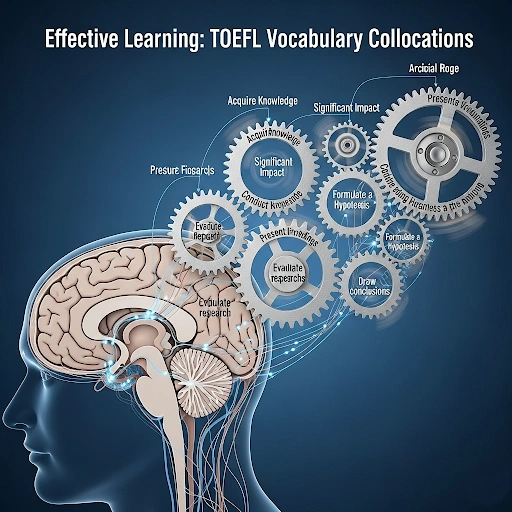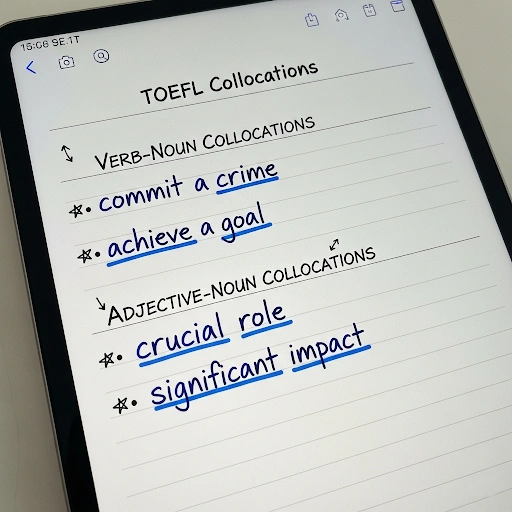An essential guide for learners to master natural-sounding English word pairings for a higher TOEFL score.
What Exactly Are Vocabulary Collocations?
A collocation is simply a pair or group of words that are habitually used together. Think of them as natural-sounding word partnerships, something you’ll often notice when studying TOEFL vocabulary collocations. While you might be able to combine any two words and have them make grammatical sense, a collocation is a combination that a native speaker would typically use.
For the TOEFL, understanding these natural word pairings is critical. The exam assesses your ability to use English in an academic context, and this includes both formal and informal collocations. Using the correct TOEFL vocabulary collocations will not only make your speech and writing sound more sophisticated, but it will also help you express complex ideas with greater precision. This is particularly important for the speaking and writing sections, where fluency and coherence are a significant part of your final score.

Why Mastering Collocations Matters for Your TOEFL Score
Memorizing collocations offers a significant advantage beyond just sounding natural. When you focus on TOEFL vocabulary collocations, you begin to notice patterns that make sentences flow more smoothly. By practicing TOEFL vocabulary collocations regularly, your speaking and writing become clearer and more accurate. Over time, relying on TOEFL vocabulary collocations helps you build confidence and express ideas in a way that feels natural to both you and your audience.
1. Boosts Your Fluency and Speaking Score
When you know the correct word pairings, you spend less time searching for the right words in your mind. Instead of thinking, “What verb goes with ‘effort’?” you can automatically say “make an effort.” This reduces hesitation and allows you to speak more smoothly and confidently, which directly impacts your speaking score.
2. Elevates Your Writing Quality and Score
The TOEFL writing section rewards candidates who demonstrate a wide range of vocabulary and grammatical structures. Using accurate and varied collocations is a clear signal to the rater that you have a high level of proficiency. Phrases like “conduct research,” “provide insight,” and “reach a consensus” are much more impactful than simpler alternatives. To understand how to further enhance your writing and speaking, you should also learn about using academic vocabulary in your writing. A high-quality essay is crucial for a great score.
3. Improves Your Listening Comprehension
While you might focus on using collocations, knowing them also helps you understand others. Native speakers and official TOEFL recordings use these natural word combinations constantly. If you hear the phrase “take into account,” and you’ve learned it as a single unit of meaning, you won’t have to pause and try to figure out what “take” and “account” mean separately. This speeds up your comprehension and allows you to follow lectures and conversations more easily.
4. Increases Vocabulary Retention
Learning words in isolation is difficult. The human brain is much better at remembering words in context. By learning TOEFL vocabulary collocations, you are learning words in a meaningful and memorable way. For example, learning the noun “impact” with the verbs “have a significant impact” or “minimize the impact” makes it easier to recall and use the word correctly in the future.
How to Effectively Learn and Use Collocations
It’s also helpful to notice TOEFL vocabulary collocations while listening to lectures, podcasts, or even movies, since they reveal how native speakers naturally connect words. Paying attention to TOEFL vocabulary collocations in real conversations makes it easier to understand tone and meaning. By observing TOEFL vocabulary collocations in different contexts, learners can develop a more natural flow in speaking. Over time, consistent exposure to TOEFL vocabulary collocations will improve both accuracy and fluency.
- Read Widely and Actively: Read authentic academic materials like university textbooks, scientific articles, and credible news sources. Pay attention to how words are paired. If you see the word “challenge,” notice if it’s paired with “pose a challenge” or “face a challenge.” Make a note of these pairings.
- Keep a Collocation Journal: Dedicate a notebook or a digital document specifically to collocations. Organize it by topic (e.g., Environment, Education, Science) or by word type (e.g., Adjective + Noun). When you encounter a new collocation, write it down in a full sentence to give it context.
- Use a Collocation Dictionary: Dictionaries like the Oxford Collocations Dictionary are invaluable tools. They list common word pairings for thousands of headwords. When you look up a word, you can see all the verbs, nouns, and adjectives it typically co-occurs with.
- Practice Speaking and Writing: The best way to solidify your knowledge is by using it. Deliberately try to incorporate new collocations into your practice essays and speaking responses. Record yourself speaking to identify where you’re using awkward phrasing and then correct it with a natural collocation. This iterative process of practice and self-correction is key.
A Deep Dive into Key TOEFL Collocation Categories
To truly master TOEFL vocabulary collocations, you need to understand the common patterns. Here are some of the most important categories, with examples you are likely to encounter in the exam.
Verb + Noun Collocations
This is one of the most common types of collocations. The verb and noun together create a specific action or concept.
- Verb + Idea:
pose a question,present a case,generate a hypothesis - Verb + Research:
conduct research,analyze data,formulate a theory - Verb + Problem:
address a problem,solve a problem,tackle an issue - Verb + Change:
bring about change,undergo a transformation,facilitate development
Example Sentence: “The research team will conduct research to generate a hypothesis about the observed phenomenon.”
Adjective + Noun Collocations
These collocations use an adjective to describe a noun in a natural way, and this pattern is often highlighted in TOEFL vocabulary collocations. By noticing how words naturally pair, learners become more confident in using TOEFL vocabulary collocations in both writing and speaking. Exposure to authentic materials helps you recognize TOEFL vocabulary collocations quickly, making comprehension easier. Over time, practicing TOEFL vocabulary collocations in context will make your English sound more fluent and accurate.
- Adjective + Impact:
significant impact,detrimental effect,profound influence - Adjective + Development:
rapid development,sustainable growth,technological advancements - Adjective + Evidence:
compelling evidence,concrete proof,sufficient information - Adjective + Issue:
critical issue,pressing concern,controversial topic
Example Sentence: “The new policy had a significant impact on the local economy, but it also raised a pressing concern about social equity.”
Adverb + Adjective Collocations
These are used to intensify or qualify an adjective.
absolutely essential,deeply committed,highly effective,vastly different
Example Sentence: “It is absolutely essential that students understand the material before the exam.”
Adverb + Verb Collocations
Similar to the above, these are used to modify the verb.
carefully consider,fully understand,strictly enforce,widely accepted
Example Sentence: “The committee will carefully consider all of the proposals before making a final decision.”

Common Mistakes to Avoid When Using Collocations
- Translating Directly: The biggest mistake is translating a collocation directly from your native language. For example, in some languages, you might “give an exam,” but in English, you “take an exam.”
- Choosing the Wrong Preposition: Prepositions are tricky, but they are part of the collocation. For example, you are “aware of” something, not “aware about” something.
- Using a Synonym That Doesn’t Fit: While “large” and “big” are often synonyms, you would say “large-scale project,” not “big-scale project.” Learning the correct pairings is crucial.
- Overusing a Single Collocation: Even if you learn a great phrase like “draw a conclusion,” try to vary your language. You could also say “reach a conclusion” or “come to a conclusion.”
Expert Tips and Best Practices
- Think in Chunks: When you read or listen to English, don’t just process one word at a time. Try to process the phrases as a whole. This is how native speakers understand and produce language. Instead of thinking of “make” and “effort” separately, internalize the entire chunk: “make an effort.”
- Use Spaced Repetition: Use flashcard apps or spaced repetition software like Anki to help you remember collocations. Instead of putting a single word on the card, write the entire collocation (e.g.,
sustain economic growth). The app will show you the card at optimal intervals to help you remember it long-term. - Practice with a Partner: Find a study partner and try to have conversations where you both try to use a specific set of collocations you’ve been working on. This is a fun and interactive way to practice.
- Read the Right Materials: If you’re a non-native speaker, you want to read materials that are well-written and use natural English. Stick to reputable sources like The Economist, The New York Times, and academic journals. Avoid blogs or articles that might be written by other non-native speakers, as they might have errors.

TOEFL Collocation FAQ
Q1: What’s the difference between a collocation and an idiom?
A: A collocation is a natural word pairing (e.g., make a mess). The meaning is usually obvious from the individual words. An idiom, on the other hand, is a fixed expression with a meaning that cannot be understood from the individual words alone (e.g., break a leg means good luck).
Q2: How many collocations do I need to learn for the TOEFL?
A: There’s no magic number, but focusing on the most frequent and useful academic collocations is key. Aim to learn several hundred to a thousand and, more importantly, learn how to use them correctly in your writing and speaking.
Q3: Can I use an online translator to find collocations?
A: While some advanced translators can help, a dedicated collocation dictionary or a corpus is a much more reliable tool. Translators can sometimes give you a literal translation that doesn’t use the correct natural English word pairing.
Q4: Should I memorize long lists of collocations?
A: No, that’s not an effective method. The best way to learn is by encountering them in context and actively using them in your own writing and speaking. A passive approach of memorizing lists is less likely to lead to long-term retention.
Q5: Will using collocations guarantee a high score on the TOEFL?
A: While using correct collocations is a significant part of a high score, it’s not the only factor. You must also have strong grammar, a wide vocabulary, and the ability to organize your thoughts and ideas coherently.
Conclusion
By learning how TOEFL vocabulary collocations appear in reading passages and listening tasks, you can significantly improve comprehension skills. Instead of translating word by word, recognizing common TOEFL vocabulary collocations helps you follow arguments and main ideas more smoothly. This deeper awareness of TOEFL vocabulary collocations will not only strengthen your test performance but also make academic texts easier to understand. Over time, practicing TOEFL vocabulary collocations in different contexts will also enhance your confidence when encountering academic materials.
To continue your journey into cloud security, consider the in-depth resources from the Cloud Security Alliance (CSA), a leading authority on cloud best practices. For more hands-on guides, check out our other posts on building a secure digital toolkit.
